family
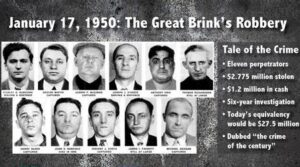
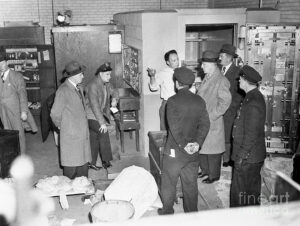 On January 17, 1950, eleven men conspired to steal over $2 million, which is equivalent to 29 million today, from the Brink’s Armored Car depot in Boston, Massachusetts. It was nearly the perfect crime, because the culprits were not apprehended until January 1956, just days before the statute of limitations for the expired. I guess, there really is no such thing as a perfect crime.
On January 17, 1950, eleven men conspired to steal over $2 million, which is equivalent to 29 million today, from the Brink’s Armored Car depot in Boston, Massachusetts. It was nearly the perfect crime, because the culprits were not apprehended until January 1956, just days before the statute of limitations for the expired. I guess, there really is no such thing as a perfect crime.
The Brink’s robbery was masterminded by Anthony “Fats” Pino, who was a career criminal. Pino recruited a group of 10 other men to stake out the depot for 18 months to figure out when it held the most money. Pino’s men then managed to steal plans for the depot’s alarm system, returning them before anyone noticed they were gone. This operation was one of patience and perseverance.
On January 17, the thieves entered the depot with copied keys. They were wearing navy blue coats and chauffeur’s caps, that were similar to the Brink’s employee uniforms, and they wore rubber Halloween masks. Their costumes surprised the employees, and the thieves tied up several employees inside the company’s counting room. They filled 14 canvas bags with cash, coins, checks, and money orders, for a total weight of more than half a ton. The men were out and in their getaway car in about 30 minutes. Their haul? More than $2.7 million, which was the largest robbery in US history up until that time.
The robbery was carried out with perfect precision. No one was hurt. Virtually no clues were left behind by the thieves, with the exception of the rope used to tie the employees and one of the chauffeur’s caps. Following the robbery, the gang promised to stay out of trouble and not touch the money for six years in order for the statute of limitations to run out. Once the statute had passed, they were home free. They might have made it too, except for the fact that one man, Joseph “Specs” O’Keefe got into trouble, and left his share with another member in order to serve a prison sentence for the other burglary. While in jail, O’Keefe began to break. He began to write bitter letters to his cohorts, demanding money and hinting he might talk if they didn’t get him some. They were getting so close to their goal, and they couldn’t let O’Keefe mess that us for them, so they decided to send a hit man to kill him, but the hit man got caught before completing his job. Knowing now that he had been betrayed, and the wounded O’Keefe made a deal with the FBI to testify against his fellow robbers.
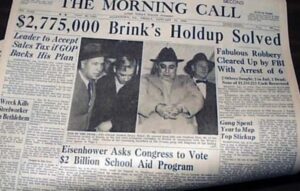
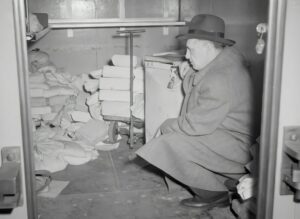 Their perfect crime was quickly unraveling now. Eight of the Brink’s robbers were caught, convicted, and given life sentences. Two more died before they could go to trial. Only a small part of the money was ever recovered, with the rest said to be hidden in the hills north of Grand Rapids, Minnesota, which would be impossible to locate. So ended the perfect, but not so perfect Brink’s robbery. The money wasn’t recovered, but the robbers didn’t get it either.
Their perfect crime was quickly unraveling now. Eight of the Brink’s robbers were caught, convicted, and given life sentences. Two more died before they could go to trial. Only a small part of the money was ever recovered, with the rest said to be hidden in the hills north of Grand Rapids, Minnesota, which would be impossible to locate. So ended the perfect, but not so perfect Brink’s robbery. The money wasn’t recovered, but the robbers didn’t get it either.
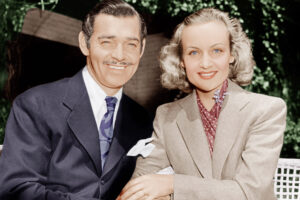
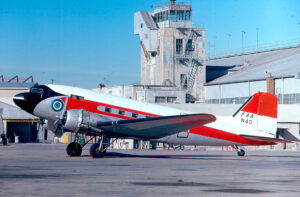 Carole Lombard was a fierce patriot, and knew that her actor husband, Clark Gable wanted to get into the war. Lombard knew that Clark Gable was officer material. Still, at the time, he had other obligations, so he waited. That wait came to an end, a few months after Lombard was killed on January 16, 1942, when the plane on which she was a passenger, flew into a cliff. Lombard’s flight, TWA Flight 3 was a on a twin-engine Douglas DC-3-382 propliner, registration NC1946, operated by Transcontinental and Western Air (TWA). It was a scheduled domestic passenger flight from New York, New York, to Burbank, California, in the United States, via several stopovers including Las Vegas, Nevada. On January 16, 1942, at 7:20pm PST, just fifteen minutes after takeoff from Las Vegas Airport (now Nellis Air Force Base) bound for Burbank, the aircraft was destroyed when it crashed into a sheer cliff on Potosi Mountain. It was determined that n error in compass heading and the blackout of most of the beacons in the neighborhood of the accident made necessary by the war emergency caused the crash. Lombard, renowned for her roles in screwball comedies such as “My Godfrey” and “To Be or Not to Be,” and for her marriage to Gable was just 33 years old.
Carole Lombard was a fierce patriot, and knew that her actor husband, Clark Gable wanted to get into the war. Lombard knew that Clark Gable was officer material. Still, at the time, he had other obligations, so he waited. That wait came to an end, a few months after Lombard was killed on January 16, 1942, when the plane on which she was a passenger, flew into a cliff. Lombard’s flight, TWA Flight 3 was a on a twin-engine Douglas DC-3-382 propliner, registration NC1946, operated by Transcontinental and Western Air (TWA). It was a scheduled domestic passenger flight from New York, New York, to Burbank, California, in the United States, via several stopovers including Las Vegas, Nevada. On January 16, 1942, at 7:20pm PST, just fifteen minutes after takeoff from Las Vegas Airport (now Nellis Air Force Base) bound for Burbank, the aircraft was destroyed when it crashed into a sheer cliff on Potosi Mountain. It was determined that n error in compass heading and the blackout of most of the beacons in the neighborhood of the accident made necessary by the war emergency caused the crash. Lombard, renowned for her roles in screwball comedies such as “My Godfrey” and “To Be or Not to Be,” and for her marriage to Gable was just 33 years old.
Gable and Lombard met in 1932 during the filming of “No Man of Her Own.” At that time, Gable was beginning his as one of Hollywood’s top leading men, while Lombard was a talented comedic actress striving to prove herself in more serious roles. Both were married at the time. Gable was married to a wealthy Texas widow ten years his senior, and Lombard to actor William Powell. Initially, neither showed much interest in the other, but when they met again three years later, Lombard had divorced Powell, and Gable was separated from his wife. Their relationship then took a different turn. Much to the media’s delight, the new couple was open with their affection, calling each other Ma and Pa and exchanging quirky, expensive gifts. In early 1939, Gable’s wife finally granted him a divorce, and he married Lombard that April.
In January 1942, shortly after America’s entry into World War II, Howard Dietz, publicity director of MGM film studio, enlisted Lombard for a tour to sell war in her home state of Indiana. Gable, who had been asked to serve as the of the actors’ branch the wartime Hollywood Victory Committee, remained in Los Angeles, where he was set to begin filming “Somewhere I’ll Find You” with Lana Turner. Dietz advised Lombard to avoid airplane travel due to his fears about its reliability and safety, so she completed most of the trip by train, stopping at various locations en route to Indianapolis and raising approximately $2 million for the war effort.
It was a good trip, but Lombard was tired and didn’t want to wait for the train for the return trip. Instead, she boarded the TWA DC-3 in Las Vegas with her mother, Elizabeth Peters, and a group that included the MGM publicity agent Otto Winkler and 15 young Army pilots. Shortly after takeoff, the plane veered off course. Warning beacons that might have helped guide the pilot had been blacked out because of fears about Japanese bombers, and the plane smashed into a cliff near the top of Potosi Mountain. Search parties were able to retrieve Lombard’s body, and she was buried next to her mother at Forest Lawn Cemetery in Glendale, California, under a marker that read “Carole Lombard Gable.”
Overcome with grief and alone in the empty house he had shared with Lombard, Gable resorted to heavy drinking and struggled to complete his work on “Somewhere I’ll Find You.” He was consoled by concerned friends, including the actress, Joan Crawford. In August, following the Japanese attack on Pearl Harbor, Gable decided to enlist in the US Army Air Force. He spent the of the war in the United Kingdom and flew several combat missions (including one to Germany), earning multiple decorations for his efforts. He would marry twice more, but upon his death in 1960, Gable was interred at Forest Lawn, next to Lombard…his one true love.
Gable’s military service was marked by his dedication to aviation and combat operations. He was assigned to the 351st Bombardment Group as B-17 Flying Fortress gunner bomber pilot. His service was characterized by a combination of flying combat missions and supporting morale efforts. One of Gable’s notable contributions during the war was his involvement in the production of a documentary titled “Combat America” (1943). The film, produced and narrated by Gable, aimed to document the experiences of American bomber crews and underscore the importance of the war effort. This documentary was a significant endeavor and demonstrated Gable’s commitment to promoting the Allied cause.
While it was distinguished, Gable’s military service was not without its challenges. He faced the dangers of 
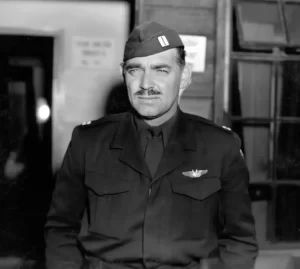 combat missions and experienced the stresses and hardships of war. He was not mollycoddled because he was an actor. Over there, he persevered to be “just one of the men.” Despite these challenges, he remained committed to his duties and earned the respect of his fellow servicemen. Major Clark Gable’s military career was marked by his bravery and dedication to the war effort. He received the Air Medal and the Distinguished Flying Cross. His personal life might have been in a shambles, but his wife would have been very proud of his service.
combat missions and experienced the stresses and hardships of war. He was not mollycoddled because he was an actor. Over there, he persevered to be “just one of the men.” Despite these challenges, he remained committed to his duties and earned the respect of his fellow servicemen. Major Clark Gable’s military career was marked by his bravery and dedication to the war effort. He received the Air Medal and the Distinguished Flying Cross. His personal life might have been in a shambles, but his wife would have been very proud of his service.

 My great grandnephew, Nathan Kirk is a sweet baby boy who is growing up so fast. His first year is already behind him and he has accomplished so much. He is walking now, and he has stolen the hearts of his parents, Siara and Chris Kirk…along with everyone else he comes across. When he smiles, his whole face lights up, and that makes everyone else happy. I’m told that his name means “gift from Heaven” and nothing could be truer. Nathan is the rainbow baby of my grandniece, Siara, who lost her first son when he was just three months old. Nathan has helped her heal. She will always miss Alec, but Nathan has truly been a healing gift.
My great grandnephew, Nathan Kirk is a sweet baby boy who is growing up so fast. His first year is already behind him and he has accomplished so much. He is walking now, and he has stolen the hearts of his parents, Siara and Chris Kirk…along with everyone else he comes across. When he smiles, his whole face lights up, and that makes everyone else happy. I’m told that his name means “gift from Heaven” and nothing could be truer. Nathan is the rainbow baby of my grandniece, Siara, who lost her first son when he was just three months old. Nathan has helped her heal. She will always miss Alec, but Nathan has truly been a healing gift.
Nathan makes the cutest little faces, and he is very photogenic. I just love seeing the latest pictures of him. Nathan loves his  mommy and daddy, and his face lights up when they come into the room. Of course, there have been many firsts in his short life. He loves things like singing with his grandma, Chantel Balcerzak. He has also been very busy filling his mouth up with lots of teeth. His mommy and Daddy better get ready to start making his steaks…now that he has teeth.
mommy and daddy, and his face lights up when they come into the room. Of course, there have been many firsts in his short life. He loves things like singing with his grandma, Chantel Balcerzak. He has also been very busy filling his mouth up with lots of teeth. His mommy and Daddy better get ready to start making his steaks…now that he has teeth.
Nathan has been initiated into the world of sports too. He has attended football games in Laramie with his parents, watching the Wyoming Cowboys. And I’m sure his grandpa, Dave Balcerzak has introduced him to the Pittsburgh Steelers too. I’m not sure who his daddy likes, but if it’s not the Steelers, I’m sure he is initiating Nathan into the other team too. No matter what, I know that Nathan will like lots of different kinds of sports, because he is his daddy’s boy, after all, not to mention his cheerleader mommy’s boy. It would be hard to be 
 their kid without liking sports. Nevertheless, right now, he has other things on his mind. Things like learning to talk, run, and of course, eat. Boys always have big appetites.
their kid without liking sports. Nevertheless, right now, he has other things on his mind. Things like learning to talk, run, and of course, eat. Boys always have big appetites.
Nathan’s real name is Nathaniel, but he has gone by both versions since he was born. Of course, there are other nicknames too, but I think most people call in Nathan. As with all kids, the nicknames he might use later on with be of his own choosing or something someone gives his that just sticks. Whatever nickname he uses later on, I know it will fit him perfectly. For now, he is too busy just getting to be a big boy. Today is Nathan’s 1st birthday. Happy birthday Nathan!! Have a great day!! We love you!!

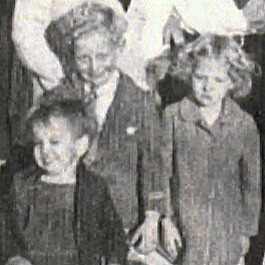 My uncle, Wayne Byer was an amazing skater. He actually started skating “for profit” at seven years old, when he worked at the skating rink. I’m not sure how that worked exactly, with child labor laws, but likely it wasn’t considered a real job, and he was “paid” in free skate time. As he got older, he became an excellent skater, even perfecting the trick of skating so low to the ground, that he could light a match for his cigarette by scraping it on the floor with his teeth. I don’t know how long he worked there, that just the story I was told.
My uncle, Wayne Byer was an amazing skater. He actually started skating “for profit” at seven years old, when he worked at the skating rink. I’m not sure how that worked exactly, with child labor laws, but likely it wasn’t considered a real job, and he was “paid” in free skate time. As he got older, he became an excellent skater, even perfecting the trick of skating so low to the ground, that he could light a match for his cigarette by scraping it on the floor with his teeth. I don’t know how long he worked there, that just the story I was told.
Uncle Wayne was always a trickster, and he loved to pick on the girls. They never really minded it too much. Uncle Wayne was pretty popular with the ladies. One of the things he used to do was to hide in the trees along the route he knew the girls had to walk, so he could scare them. That can be a little disconcerting, of course, because you don’t know if he is there or not. Nevertheless, with his winning smile, they always forgave him.
Another of Uncle Wayne’s escapades was known a “Hooky Bobbing” and involved holding onto a moving vehicle, such as a car or truck, while it is driving on snow or ice. The person doing this gets a free but dangerous ride, often without the motorist’s knowledge. While I’ve seen this, in movies or videos, I think I would be too scared…or maybe the word is wise, to do such a thing. Still, boys being boys, this type of activity was attempted or made a habit of, at least by the gutsy ones. Uncle Wayne was just gutsy and mischievous enough to be one of those boys.
Uncle Wayne was the younger of my grandparents, George and Hattie Byer’s two sons, and his older brother, Larry was the shorter of the two. I don’t know if that really bothered Uncle Larry or not, but at the very least, he pretended that it did. When we had professional family portraits done years ago and the family Christmas party, the nine siblings were lined up in order of birth with Grandma and Grandpa. When you looked at the 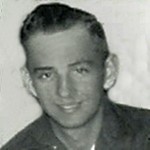
 picture, you saw the mischievous smiles on Uncle Larry and Uncle Wayne’s faces. My mom, Collene Spencer had the dubious honor of standing in the middle of the boys, due to her place of birth. One might think that they were picking on Mom, but the reality was that Uncle Larry had found a small ledge behind them, and was standing up on it so he could look as tall as Uncle Wayne. They both knew what he was doing, and they were both laughing about it. I’m surprised they could keep from laughing outright. They were a couple of characters for sure. Today is my Uncle Wayne’s 87th birthday. Happy birthday Uncle Wayne!! Have a great day!! We love you!!
picture, you saw the mischievous smiles on Uncle Larry and Uncle Wayne’s faces. My mom, Collene Spencer had the dubious honor of standing in the middle of the boys, due to her place of birth. One might think that they were picking on Mom, but the reality was that Uncle Larry had found a small ledge behind them, and was standing up on it so he could look as tall as Uncle Wayne. They both knew what he was doing, and they were both laughing about it. I’m surprised they could keep from laughing outright. They were a couple of characters for sure. Today is my Uncle Wayne’s 87th birthday. Happy birthday Uncle Wayne!! Have a great day!! We love you!!
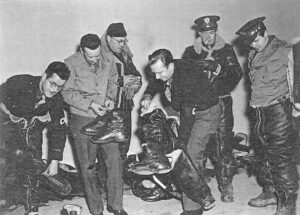
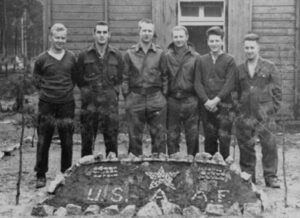 We have all seen war correspondents, and in fact we are used to being kept up to date on the happenings of a war. Of course, that wasn’t always the case. In the 18th and 19th centuries, journalists often accompanied the military units offering firsthand accounts that were frequently influenced by patriotism or propaganda. These early correspondents established the early foundation for the profession, concentrating mainly on significant battles and strategic developments. When you think about it, while their reports might have been colored for those reason, it still took an element of courage to put themselves in harm’s way like that.
We have all seen war correspondents, and in fact we are used to being kept up to date on the happenings of a war. Of course, that wasn’t always the case. In the 18th and 19th centuries, journalists often accompanied the military units offering firsthand accounts that were frequently influenced by patriotism or propaganda. These early correspondents established the early foundation for the profession, concentrating mainly on significant battles and strategic developments. When you think about it, while their reports might have been colored for those reason, it still took an element of courage to put themselves in harm’s way like that.
One of the early groups to be assigned to on planes was known as the Writing 69th. They were a group of eight American journalists who had to train as gunners to fly bomber missions over Germany with the US Eighth Air Force during World War II. The Writing 69th was christened by one of the 8th Air Force’s public relations officers, possibly Hal Leyshon or Joe Maher. The group also considered the names “The Flying Typewriters” or “Legion of the Doomed,” but in the end, the Writing 69th won the day. The Writing 69th included Walter Cronkite, Andy Rooney, Bigart, Robert Post, Paul Manning, Denton Scott, William Wade, and Gladwin Hill.
All of these reporters, all of whom accompanied the 8th Air Force, were required to undergo a rigorous training course in just one week. You might wonder why they needed to be trained, because they were just writers after all. Nevertheless, it was required that they be trained in a multitude of tasks, including how to shoot weapons, despite rules barring non-combatants from carrying a weapon into combat. The men were also trained on how to adjust to high altitudes, parachuting, and enemy identification.
The first and final mission for the Writing 69th occurred on February 26, 1943. A group of American B-24s and B-17s were dispatched to attack the Focke-Wulf aircraft factory in Bremen, Germany. However, due to overcast skies over Bremen, the bombing run had to be diverted to a secondary target, the submarine pens at Wilhelmshaven. Were it not for what happened on that mission, the Writing 69th might have gone on more missions. Of the eight journalists who comprised the Writing 69th, only six went on that fateful mission. They were Post, Cronkite, Rooney, Wade, Bigart, and Hill. Over Oldenburg, Germany, the American bomber group encountered German fighters. The B-24 carrying Robert Post was shot down and exploded in mid-air, killing eight Air crew members, and Post. The other aircraft were able to return safely, although Rooney’s plane 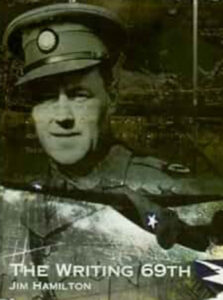
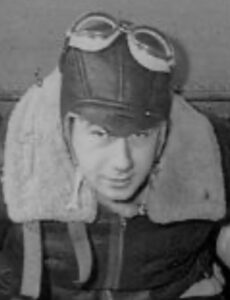 sustained some flak (anti-aircraft) damage. Post’s death effectively ended the days of reporters flying on bombing missions. Although others, including Scott and Manning, both of whom missed the Wilhelmshaven raid, did fly after this mission. Nevertheless, it was not nearly as widespread as it might have been had not Post been killed.
sustained some flak (anti-aircraft) damage. Post’s death effectively ended the days of reporters flying on bombing missions. Although others, including Scott and Manning, both of whom missed the Wilhelmshaven raid, did fly after this mission. Nevertheless, it was not nearly as widespread as it might have been had not Post been killed.
I never gave much thought to the journalists who worked as war correspondents, it always just seemed like a normal part of their jobs. Of course, I knew that they were in war zones, and that there could be danger, but somehow, I thought that there was like some “unwritten code” that kept the reporters safe. Of course, that idea was ridiculous, but looking from the protected distance of a television set, a world away, that was where I was.

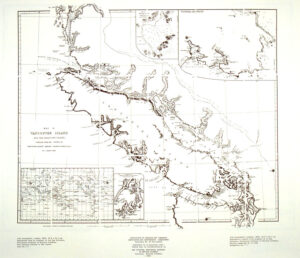 Before it became part of Canada, the Island of Vancouver was known as the Colony of Vancouver Island, but it was officially referred to the Island of Vancouver and its Dependencies. It was a Crown colony of British North America from 1849 to 1866. Then, in 1886, it was united with the mainland to form the Colony of British Columbia. The united colony joined Canadian Confederation in 1871, thereby becoming part of Canada. The colony included Vancouver Island and the Gulf Islands in the Strait of Georgia. The transitions the island made over those years are fairly common as land ownership went over the centuries.
Before it became part of Canada, the Island of Vancouver was known as the Colony of Vancouver Island, but it was officially referred to the Island of Vancouver and its Dependencies. It was a Crown colony of British North America from 1849 to 1866. Then, in 1886, it was united with the mainland to form the Colony of British Columbia. The united colony joined Canadian Confederation in 1871, thereby becoming part of Canada. The colony included Vancouver Island and the Gulf Islands in the Strait of Georgia. The transitions the island made over those years are fairly common as land ownership went over the centuries.
The first European person to set foot on Vancouver Island was Captain James Cook landing first on the island at Nootka Sound in 1778 during his third voyage. Cook spent a month in the area, claiming the territory for Great Britain. Trader John Meares arrived in 1786 and established a single-building trading post near the native village of Yuquot (Friendly Cove) at the entrance to Nootka Sound in 1788. The fur trade began expanding across the island, eventually leading to permanent settlement.
The Spanish Empire also explored the region. In 1789, Commandant Esteban José Martínez constructed a fort at Friendly Cove on Vancouver Island and seized British ships, stating that they had sovereignty. The fort was re-established in 1790 Francisco de Eliza, and a small community developed around it. Ownership of the remained contested between Spain and Britain.
In 1792, Captain George Vancouver arrived to with Spanish Commandant Juan Francisco de Bodega y Quadra. The plan was to negotiate an agreement concerning the island, but their lengthy negotiations failed to resolve the competing claims of ownership. In fact, the negotiations went so badly that the two countries nearly went to war over the issue. The negotiation-confrontation became known as the Nootka Crisis. Disaster was finally averted when both parties agreed to recognize the other’s rights to the area in the first Nootka Convention in 1790. While it was shaky, it was a preliminary step towards peace. Negotiations continued and the two countries signed the second Nootka Convention in 1793 and the third Convention in 1794. As per the final agreement, the Spanish dismantled their fort at Nootka and left the area, granting the British sovereignty over Vancouver Island and the adjoining islands, including the Gulf Islands.
It was not until 1843 that Britain, under the auspices of the Hudson’s Bay Company (HBC), established a settlement on Vancouver Island. In March 1843, James Douglas of the Hudson’s Bay Company and a missionary arrived and an area for settlement. Construction of the fort began in June. This settlement was a fur trading post originally named Fort Albert, later renamed Fort Victoria. The fort was located at the Songhees settlement of Camosack (Camosun), 200 meters northwest of the present-day Empress Hotel on Victoria Inner Harbour.
In 1846, the Oregon Treaty was signed by the British and the States to the question of the US Oregon Territory borders. The Treaty established the 49th parallel north latitude as the official border between the two countries. To ensure that Britain retained all of Vancouver Island and the southern Gulf Islands, however, it was agreed that the border would swing south around that area. Finally, in 1849, the Colony of Vancouver Island was established and leased to the Hudson’s Bay Company (HBC) for ten years at an annual fee of seven shillings, which sounds almost comical these days. Consequently, HBC moved its western headquarters from Fort Vancouver on the Columbia River (present-day Vancouver, Washington) to Fort Victoria. Chief Factor James Douglas was relocated from Fort Vancouver Fort Victoria to oversee the operations west of the Rockies.
The British colonial designated the territory as a Crown colony on 13 January 1849. Douglas was tasked with encouraging British settlement. Richard Blanshard was appointed as the colony’s governor. Blanshard 
 discovered that the HBC’s control over the affairs of the new colony was nearly absolute, and that Douglas held practical authority in the territory. There was no civil service, no police, no militia, and virtually every colonist was an employee of the Hudson’s Bay Company. Frustrated, Blanshard abandoned his post a year later and returned to England. In 1851, Blanshard’s resignation was finalized, and the colonial office appointed Douglas as governor.
discovered that the HBC’s control over the affairs of the new colony was nearly absolute, and that Douglas held practical authority in the territory. There was no civil service, no police, no militia, and virtually every colonist was an employee of the Hudson’s Bay Company. Frustrated, Blanshard abandoned his post a year later and returned to England. In 1851, Blanshard’s resignation was finalized, and the colonial office appointed Douglas as governor.

 Having a history of seismic activity, January 12, 2010’s, earthquake in Haiti was not a total shock, but what was shocking was the devastation when that quake turned out to be massive. So devastating was the quake, that there was an immediate global response. Unfortunately, that amazing response didn’t precipitate the full recovery of the tiny nation.
Having a history of seismic activity, January 12, 2010’s, earthquake in Haiti was not a total shock, but what was shocking was the devastation when that quake turned out to be massive. So devastating was the quake, that there was an immediate global response. Unfortunately, that amazing response didn’t precipitate the full recovery of the tiny nation.
Haiti’s history of seismic activity includes devastating earthquakes recorded there in 1751, 1770, 1842, and 1946. Haiti shares the island of Hispaniola with the Dominican Republic. The island lies mostly between two large tectonic plates, the North American and the Caribbean. Port-au-Prince, the capital of Haiti practically straddles this fault line. Despite knowing about the fault line and the warnings from seismologists that another earthquake was likely in the near future, the infrastructure and emergency services were not prepared to handle the effects of a natural disaster, because of the state of poverty of the country.
The 7.0 earthquake struck just before 5pm local time. The shaking was felt as far away as Cuba and Venezuela, but the epicenter was just 16 miles away from Port-au-Prince. Eight aftershocks followed in quick succession the same day, and at least 52 were recorded over the next two weeks. The quake’s effect on the area was catastrophic. All of the capital’s hospitals, with three facilities operated by Doctors Without Borders, sustained significant damage. Additionally, Port-au-Prince’s airport and seaport were rendered inoperable. Telecommunications services were severely affected, major roads were rendered impassable, and nearly 300,000 buildings, most of which were residences, were damaged beyond repair. The National Assembly building and Port-au-Prince Cathedral were also destroyed.
While the damage to the area was horrific, it pales when compared to the human toll. That number was devastating, remains incalculable. The lowest estimates put the number of deaths around 40,000 to 50,000, but the Haitian government estimated that more than 316,000 died. All of the authorities agreed that the death toll is impossible to truly count. In addition to the deaths, approximately 1 million people were displaced.
News and shocking images of the quake, including photos of the heavily-damaged National Palace, quickly brought about a massive humanitarian response. First to respond was the Dominican Republic and Dominican Red Cross, both of whom responded immediately. They brought in emergency supplies and airlifts to Dominican hospitals. Money, supplies, and manpower began to come in from nations on every continent. Port-au-Prince’s airport operated around the clock, but they could not accommodate all the arrivals. Foreign air forces, including those of the United States and Great Britain, began airlifting survivors to hospital ships located off the coast, and some supplies were dropped to the island by parachute. By January 22nd, the “Hope for Haiti” telethon had been organized, and broke records by raising $58 million in one day.
You might have thought that with all the responses, they country would be well on its way toward a full recovery, but while the humanitarian response was immediate and overwhelming, Haiti’s crippled infrastructure 
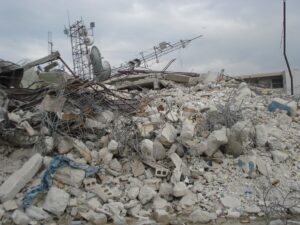 made the delivery of aid difficult. Six months later, the situation was still classified as an emergency. A million people on the island lived in tents, and a cholera epidemic that began in October claimed over 3,300 more lives. Whether or not Haiti has yet fully recovered is a matter of debate today, 15 years later, but the effects of the earthquake were unmistakable for at least the next decade.
made the delivery of aid difficult. Six months later, the situation was still classified as an emergency. A million people on the island lived in tents, and a cholera epidemic that began in October claimed over 3,300 more lives. Whether or not Haiti has yet fully recovered is a matter of debate today, 15 years later, but the effects of the earthquake were unmistakable for at least the next decade.

 My uncle, Bill Beadle, spent much of his working life in the pipe yards. Later, he owned his own rathole drilling business with his sons, Forrest and Steve, by his side. While Uncle Bill was a great machinist and an all-around mechanic, he truly loved fishing and bird hunting in the Worland area with his son, Steve the best. I am certain that is also why Uncle Bill was so content, in his later years, to live with Steve, his wife, Wanda, and their family. I can imagine they spent a lot of time discussing their fishing trips and their time walking the fields hunting for pheasants and chukars. Uncle Bill enjoyed hunting them because it was so exciting to walk the fields, waiting for that unexpected bird to fly up out of nowhere. The hunter had only seconds to react and would succeed only if he was truly skilled. Uncle Bill was truly skilled.
My uncle, Bill Beadle, spent much of his working life in the pipe yards. Later, he owned his own rathole drilling business with his sons, Forrest and Steve, by his side. While Uncle Bill was a great machinist and an all-around mechanic, he truly loved fishing and bird hunting in the Worland area with his son, Steve the best. I am certain that is also why Uncle Bill was so content, in his later years, to live with Steve, his wife, Wanda, and their family. I can imagine they spent a lot of time discussing their fishing trips and their time walking the fields hunting for pheasants and chukars. Uncle Bill enjoyed hunting them because it was so exciting to walk the fields, waiting for that unexpected bird to fly up out of nowhere. The hunter had only seconds to react and would succeed only if he was truly skilled. Uncle Bill was truly skilled.
Uncle Bill Beadle was a unique individual. He had a deep love for all things western, and particularly the Old West. It is possible that he even felt he should have been living in the era. It is not that God made a mistake by placing him in the wrong time, but sometimes our personal preferences make us feel as though we might have been better suited to a different era. His family would have disagreed with him, had he suggested that he should have lived in the Old West…mostly because we wouldn’t have wanted him not to be with us. For Uncle Bill, it was not about living in the Old West, but about his love for Wyoming, which he truly did. Nevertheless, he was a cowboy at heart and would have loved to spend time in the Old West, even if it had only been a short time…like “Back to the Future!!” 
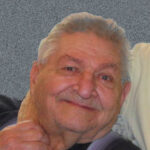
Uncle Bill was always entertaining and humorous, and I enjoyed visiting with him. When his memory began to decline, Uncle Bill could no longer attend family gatherings, and as many elderly people, he struggled to communicate with family members, and it became easier for him to stay home rather than attempt to engage in conversations. I truly miss those times with Uncle Bill. Today would have been Uncle Bill’s 96th birthday. Happy birthday in Heaven, Uncle Bill. We love and miss you very much.

 My niece, Gaby Beach has been a serious athlete since before joining the Navy, years ago. Now that she is discharged from the Navy, she has made the commitment to her health, and she has never looked back. Gaby love many kinds of sports, including hiking, weightlifting, and running. When it comes to her workouts, Gaby is fierce!! She doesn’t give up, and she doesn’t slack off. She is a very determined woman, with the mindset of being the very best she can possibly be. I have no doubt that she will meet every goal and make every dream come true.
My niece, Gaby Beach has been a serious athlete since before joining the Navy, years ago. Now that she is discharged from the Navy, she has made the commitment to her health, and she has never looked back. Gaby love many kinds of sports, including hiking, weightlifting, and running. When it comes to her workouts, Gaby is fierce!! She doesn’t give up, and she doesn’t slack off. She is a very determined woman, with the mindset of being the very best she can possibly be. I have no doubt that she will meet every goal and make every dream come true.
Gaby loves to run, and while I don’t know how many marathons and half-marathons she has participated in, I would not be surprised to find that the number is a dozen or more. If she is not competing, she is training. Her workouts are rigorous, and her runs are done with determination. I think the one thing that surprises me, an avid walker, who only runs from a bear (just 
 kidding), is that even in the middle of a long run, Gaby still has the energy to kick up her heels with a big smile on her face. I’m doing my best just to breathe in a run.
kidding), is that even in the middle of a long run, Gaby still has the energy to kick up her heels with a big smile on her face. I’m doing my best just to breathe in a run.
Gaby and my nephew, Allen Beach moved from Casper to Washington a couple of years ago, and they have been doing quite a bit of exploring and hiking the trails in the area. They have taken a couple of trips up the coast, to Utah, and to Arizona. Part of those were for runs, but the trips were amazing too. Gaby is a social girl who makes friends easily. She works as a nurse at the Veteran’s Hospital in Eugene, Oregon, and she absolutely loves her job. Being a veteran herself, Gaby has a heart for veterans. In her work, she deals with 
 various ailments, disabilities, and emotional needs of the veterans. While any nurse could care for the needs of the veterans at hospital, it occurs to me that a nurse who is also a veteran would have a unique connection to the needs of the men and women themselves, not just their bodies. I believe this is what makes Gaby perhaps the best nurse they could have at that hospital. Today is Gaby’s birthday. Happy birthday Gaby!! Have a great day!! We love you!!
various ailments, disabilities, and emotional needs of the veterans. While any nurse could care for the needs of the veterans at hospital, it occurs to me that a nurse who is also a veteran would have a unique connection to the needs of the men and women themselves, not just their bodies. I believe this is what makes Gaby perhaps the best nurse they could have at that hospital. Today is Gaby’s birthday. Happy birthday Gaby!! Have a great day!! We love you!!


 For my niece, Toni Chase and her husband, Dave, travel is always on the agenda. They always have several trips to various places, some of which are quite exotic. Toni tells me that this was “a very good year.” Over the Independence Day week, Toni and Dave took a trip to Glacier National Park with their son, James Renville and his wife Manuela…and of course, Toni and Dave’s puppies, Biscuit and Cricket. They all had an amazing time. They love doing a little hiking and exploring the lakes and rivers in the area. Later, Toni and Dave took a trip to New Mexico with his mom and sister. One of the highlights of the trip was the trip to White Rock overlooking the Rio Grande River. The view was majestic, and they absolutely loved the time together.
For my niece, Toni Chase and her husband, Dave, travel is always on the agenda. They always have several trips to various places, some of which are quite exotic. Toni tells me that this was “a very good year.” Over the Independence Day week, Toni and Dave took a trip to Glacier National Park with their son, James Renville and his wife Manuela…and of course, Toni and Dave’s puppies, Biscuit and Cricket. They all had an amazing time. They love doing a little hiking and exploring the lakes and rivers in the area. Later, Toni and Dave took a trip to New Mexico with his mom and sister. One of the highlights of the trip was the trip to White Rock overlooking the Rio Grande River. The view was majestic, and they absolutely loved the time together.
While the trips to Glacier and New Mexico were amazing, the trip that was the crème de la crème was the trip 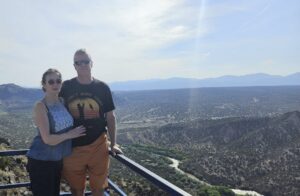
 they took to Portugal. Dave had wanted them to take this trip for their tenth wedding anniversary, but Covid-19 rather got in the way, so they finally took the trip in September. The had a wonderful time, seeing all the sights and dining in all the best places. On the first night there, Toni had shrimp, and Dave took a picture of her plate to send as a joke to her son James. How the shrimp ended up with a face of sorts, I do not know. They took lots of pictures so that they will have great memories of this trip of a lifetime.
they took to Portugal. Dave had wanted them to take this trip for their tenth wedding anniversary, but Covid-19 rather got in the way, so they finally took the trip in September. The had a wonderful time, seeing all the sights and dining in all the best places. On the first night there, Toni had shrimp, and Dave took a picture of her plate to send as a joke to her son James. How the shrimp ended up with a face of sorts, I do not know. They took lots of pictures so that they will have great memories of this trip of a lifetime.
Toni and Dave also went to a couple of concerts this year. One was an outdoor concert, and the other was at Dropkick Murphy’s. The kids went to that one too. The concerts and trips were a welcome break from the renovations they have been working on in their rental house. The house has been sold now to James and Manuela, and James is especially excited about that, as it is the house he grew up in. Toni tells me that she 
 spent just about every free second she had all winter and clear up to August working on that house getting it ready to sell to James and Manuela. The house didn’t have a lot of issues, but it was built in the 1950s, and as with any older home, things need to be repaired, updated, and modernized. All in all, it has been a busy year. Today is Toni’s birthday. Happy birthday Toni!! Have a great day!! We love you!!
spent just about every free second she had all winter and clear up to August working on that house getting it ready to sell to James and Manuela. The house didn’t have a lot of issues, but it was built in the 1950s, and as with any older home, things need to be repaired, updated, and modernized. All in all, it has been a busy year. Today is Toni’s birthday. Happy birthday Toni!! Have a great day!! We love you!!

